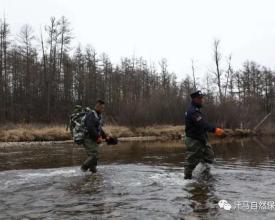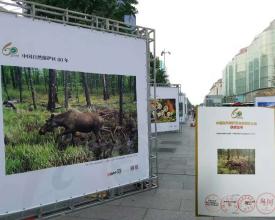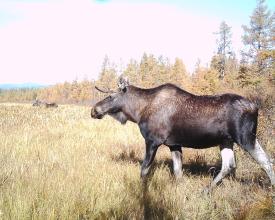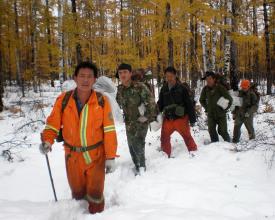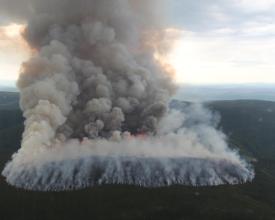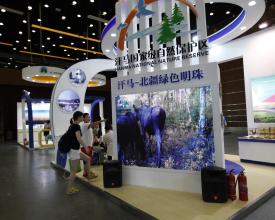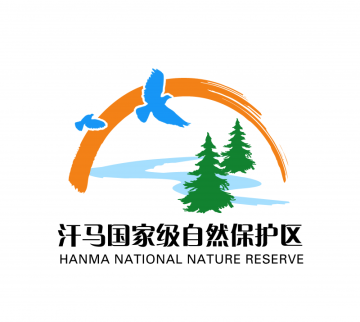
Conservation and Restoration of Moose Population in Hanma National Nature Reserve

Because of decades of logging and rapid economic development in Greater Khingan Mountains, moose population had sharply declined, and the habitat had been seriously damaged. Moose is also extremely sensitive to climate change. With the global warming, moose population constantly shrunk back northward.
In order to protect and restore the moose population in Hanma and adjacent areas, the project has conducted in-depth research on moose. Based on the research results, the protection countermeasures were formulated: 1) Project personnel carried out patrol work on a regular basis every month; 2) Fight poaching; 3) Prevent wildfires; and 4) Use various ways and means to raise awareness on the importance of protecting and restoring moose population.
Contexte
Challenges addressed
- Limited funding
- Insufficient technicians
- Large survey area
- There are only a few roads in the survey area, and many places can only be visited by foot, these makes the survey difficult.
- Facing personal security threats in the process of field survey
- Lack of historical monitoring data but long-term monitoring required
- Global climate change and frequent occurrence of extreme climate
- Frequent wildfires
Emplacement
Traiter
Summary of the process
Scientific research and monitoring is the basis. Through scientific research and monitoring, the moose population density, genetic and dispersal mechanism, nutritional adaptation strategy, gut microbial characteristics, movement characteristics, etc. are clear. Based on these results, protection strategies are formulated. Conservation and management is key to protect and restore the moose population. Awareness raising and education is the guarantee. Through the awareness raising and education materials obtained from scientific research, this work can be understood and supported by the public, and therefore the smooth development of scientific research monitoring and protection management is better guaranteed.
Building Blocks
Scientific research and monitoring
Through the fishnet method to set up camera traps, sample plots more than 20% of the nature reserve, collecting moose forage plant samples, feces samples, hair samples, etc. for lab analysis, to investigate the moose population density, genetic and dispersal mechanism, nutritional adaptation strategy, gut microbiological characteristics, movement characteristics in Hanma and adjacent areas, and to formulate protection countermeasures based on these results.
Enabling factors
Professional technical team
Sufficient funds
Effective management
Lesson learned
The most important thing to monitor moose is to have a professional technical team. Professor Jiang Guangshun from College Of Wildlife And Protected Area, Northeast Forestry University has been conducting investigation and monitoring of wildlife for many years. With professional technical knowledge, personnel, equipment and rich experience, it can ensure the smooth implementation of the project, and the results are quite reliable.
Conservation and management
Patrol work shall be carried out regularly to get the latest situation and problems in the nature reserve in time, and formulate corresponding solutions. Hanma cooperated with Forest Police of Greater Khingan Mountains in Inner Mongolia for moose anti-poaching, ensure good connectivity of migration corridors, protect wildlife from poaching and reduce human interference. Hanma cooperated with Alongshan Forestry Bureau, Jinhe Forestry Bureau and Kuduer Emergency Management Force to prevent wildfires, to avoid large-scale damage to the moose habitat in a short period of time, and to ensure the reproduction and survival of moose population.
Enabling factors
Sound legal guarantee
Sufficient law enforcement authority
Professional law enforcement team
A sufficient number of law enforcement officers
Lesson learned
The protection of wild animals must be guaranteed by relevant laws, and strong law enforcement force is needed to ensure the implementation of laws, so that people do not want, dare not, and can not poach.
Science popularization and education
Using the websites, WeChat Public Account, Newspapers, Popular Science Books, Popular Science Videos, Documentaries, News Coverage, Warning Signs, Field Education Sites, AR Hanma Exhibition Room, Ecological and Cultural Museum, Pamphlets, Summer Camps, Eco-Forums, Publicity campaigns in schools and communities, Eco-education and field studies base, etc., publicity and education are carried out to the public. This makes the public understand the importance of protecting moose population and improve the public awareness of ecological protection.
Enabling factors
Professional and easy to understand publicity materials
A popular way of publicity
Application of new media
Application of new technology
Lesson learned
Prepare different publicity materials for different target groups and adopt different publicity methods so that they can understand and accept the ideas you want to express.
Impacts
As the largest herbivore, moose is a keystone species for restoring the ecological health of the swampy grasslands and tundra. Moose is also one of the most important large herbivores in and around Hanma. This means the species has a crucial role for the ecology. Moose is the most important species for local residents. It has had close contact with many forestry workers and left many legends in Greater Khingan Mountains.
Based on the in-depth study of moose population density, genetic and dispersal mechanism, nutrition adaptation strategy, gut microbial characteristics, and movement characteristics, effective protection strategies were formulated for the adaptation mechanism of moose under global climate change. Regular patrol found and solved problems in time. A comprehensive ban on logging and severe crackdown on poaching have ensured the complete migration channel of moose and minimize human interference. Through the prevention of wildfire, the habitat of moose avoided to be destroyed in a large area in a short time. Publicity and education to the public ensured the smooth implementation of the project. Through the implementation of the whole project, not only the moose population is protected, but so do other local wild animals. The balance and stability of the ecosystem are then preserved.
Beneficiaries
- Reserve Managers
- Scientists
- Local community residents
Story
The team of Professor Jiang Guangshun from the College of Wildlife and Protected Area, Northeast Forestry University has played a huge role in this work. The team members trained the nature reserve staff who participated in the project, in camera trap monitoring, fecal sample collection, hair sample collection, plant sample collection, sample plot investigation, footprint tracking among other, and carried out these survey together.
Due to the lack of roads, many of the survey areas can only be reached on foot. Each member of the project team carried a large backpack with the equipment needed for the investigation, food, tents, sleeping bags, moisture-proof mats, etc. Sometimes it took more than a week to walk in the field.
The temperature difference between day and night in Greater Khingan Mountains is over 20 ℃. In summer, it is hot during the day, but cold at night. When raining, the night will be more humid and cold. During the day, mosquitoes were so dense that they could not be driven away. They bit the project personnel, and even blocked their sight.
In winter, the snow thickness can be over 50 cm, and the temperature can be below - 35 ℃. Project team members needed to walk at least 12 km a day, and lived in simple tents at night. Once a project team member got a hole in his shoe during the investigation. He didn't dare to rest for a while until he came back to the camp at 7:00 p.m. and his feet were numb with cold.
During the spring, the project team members were faced with serious threats from ticks and hungry brown bears. Ticks carry a variety of deadly viruses such as forest encephalitis and Lyme disease. In Greater Khingan Mountains, people die every year from tick bites. Everyone involved in the project were bitten many times by ticks, but fortunately there has been no case of death. Spring is the season when brown bears need to replenish energy after hibernation. In the course of field survey, we often encountered hungry brown bears. In particular, female brown bears with teddies are very vulnerable to attack if not handled properly.
So far, three doctors and one master have graduated from this program.
